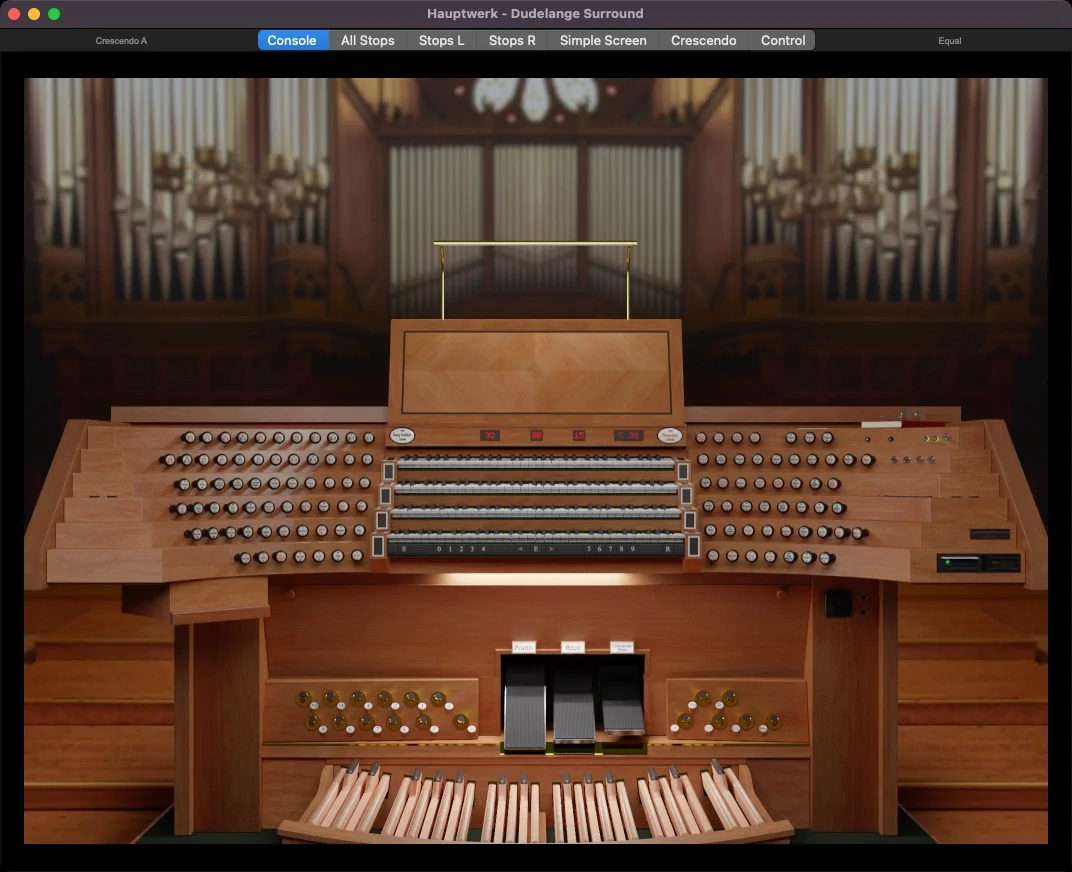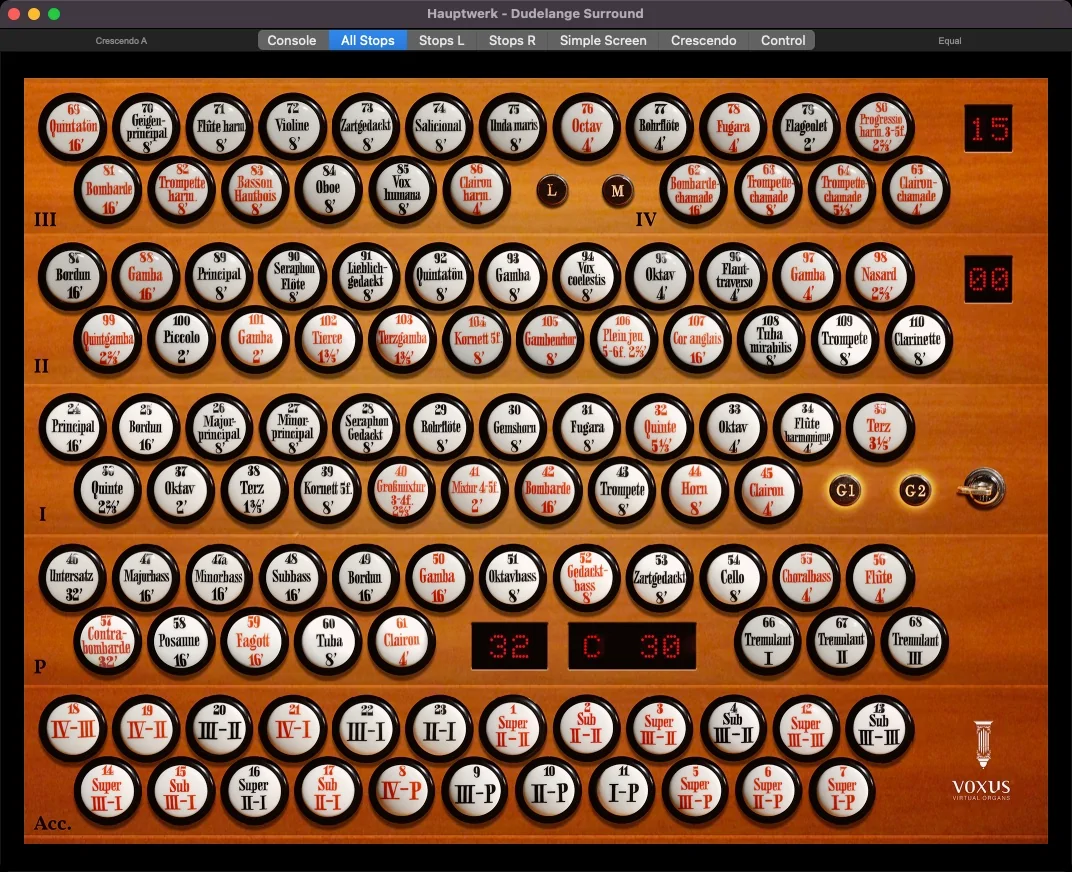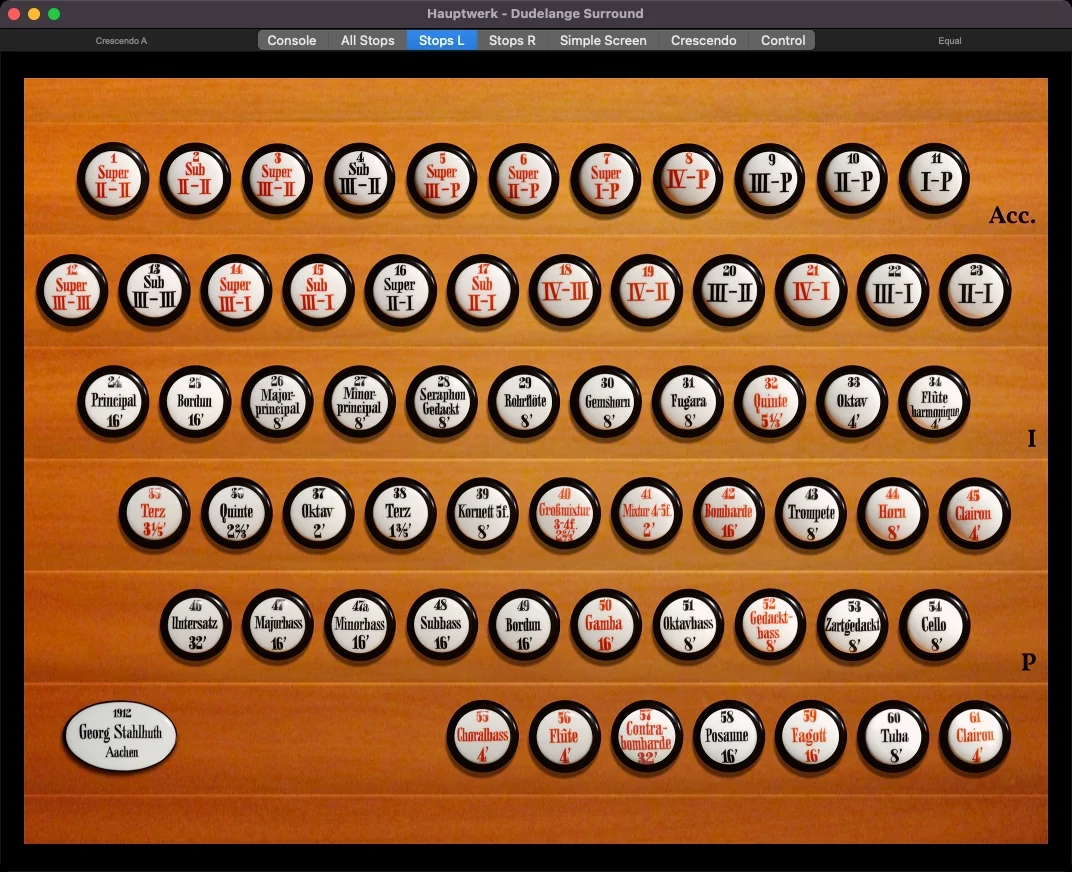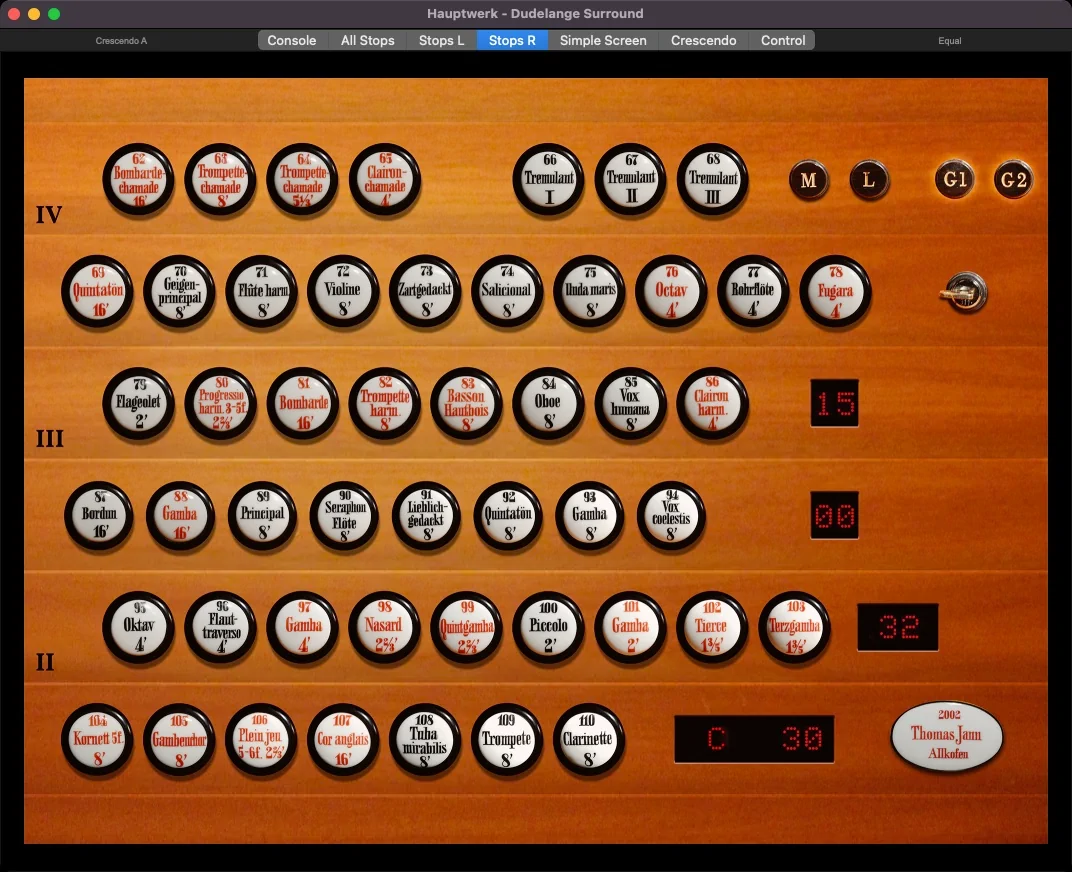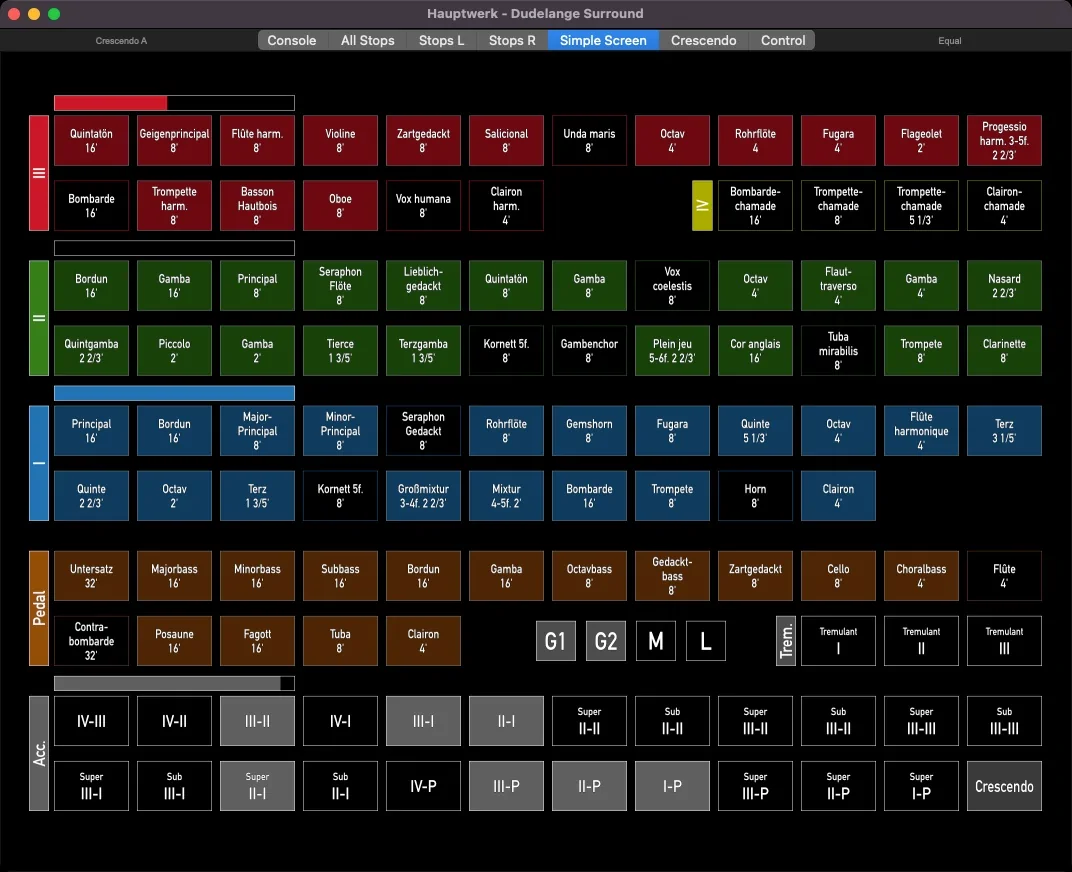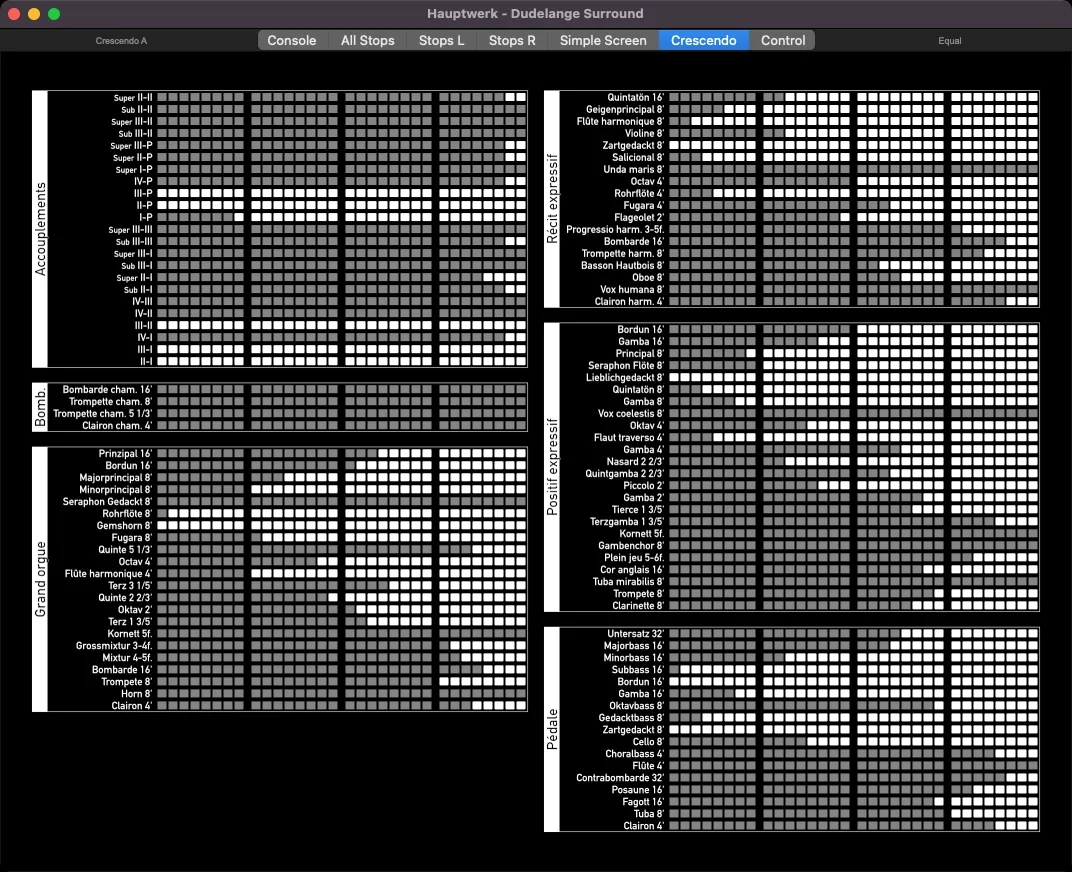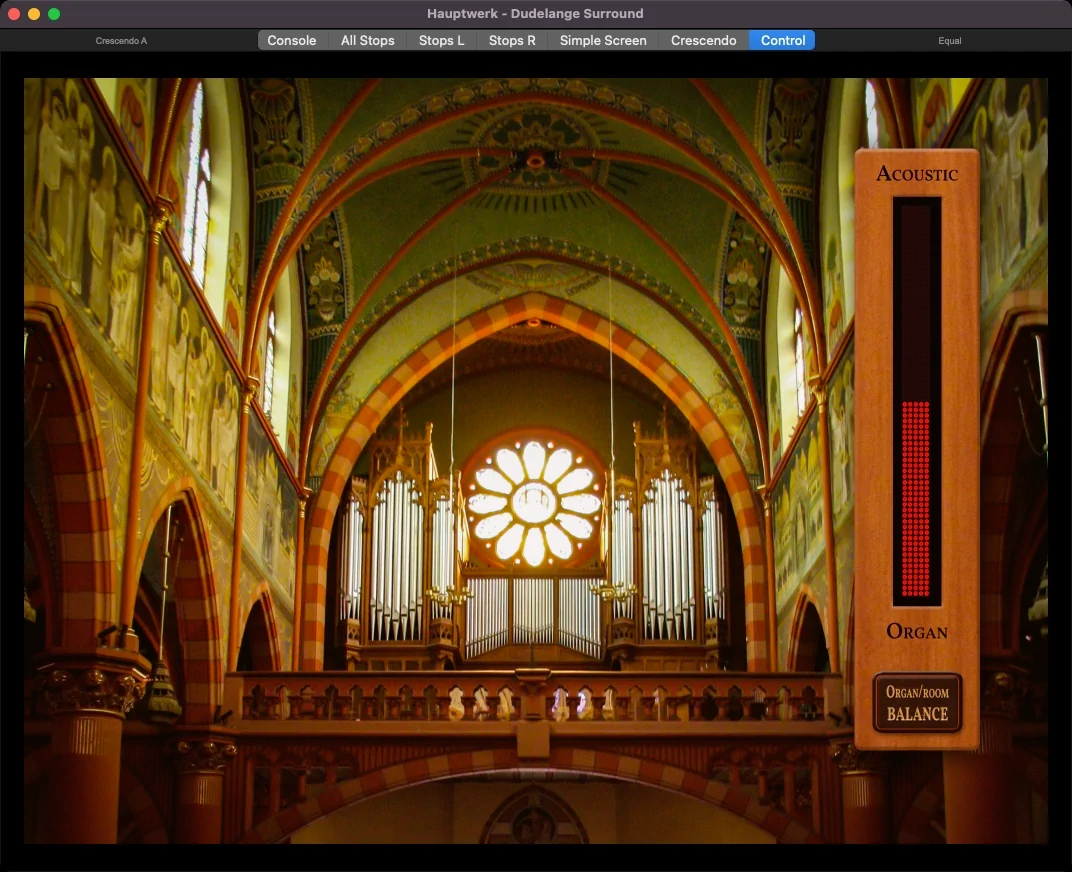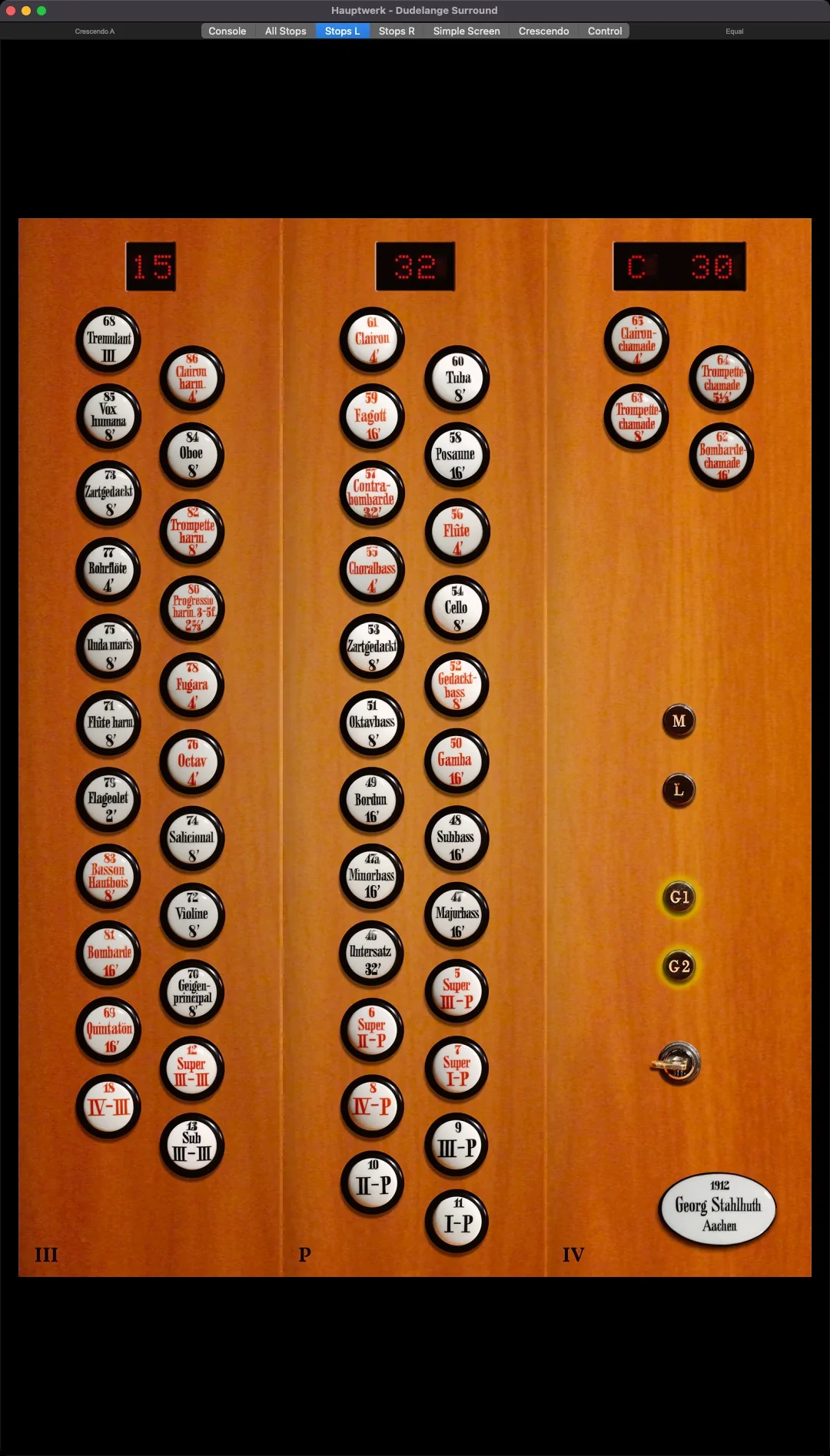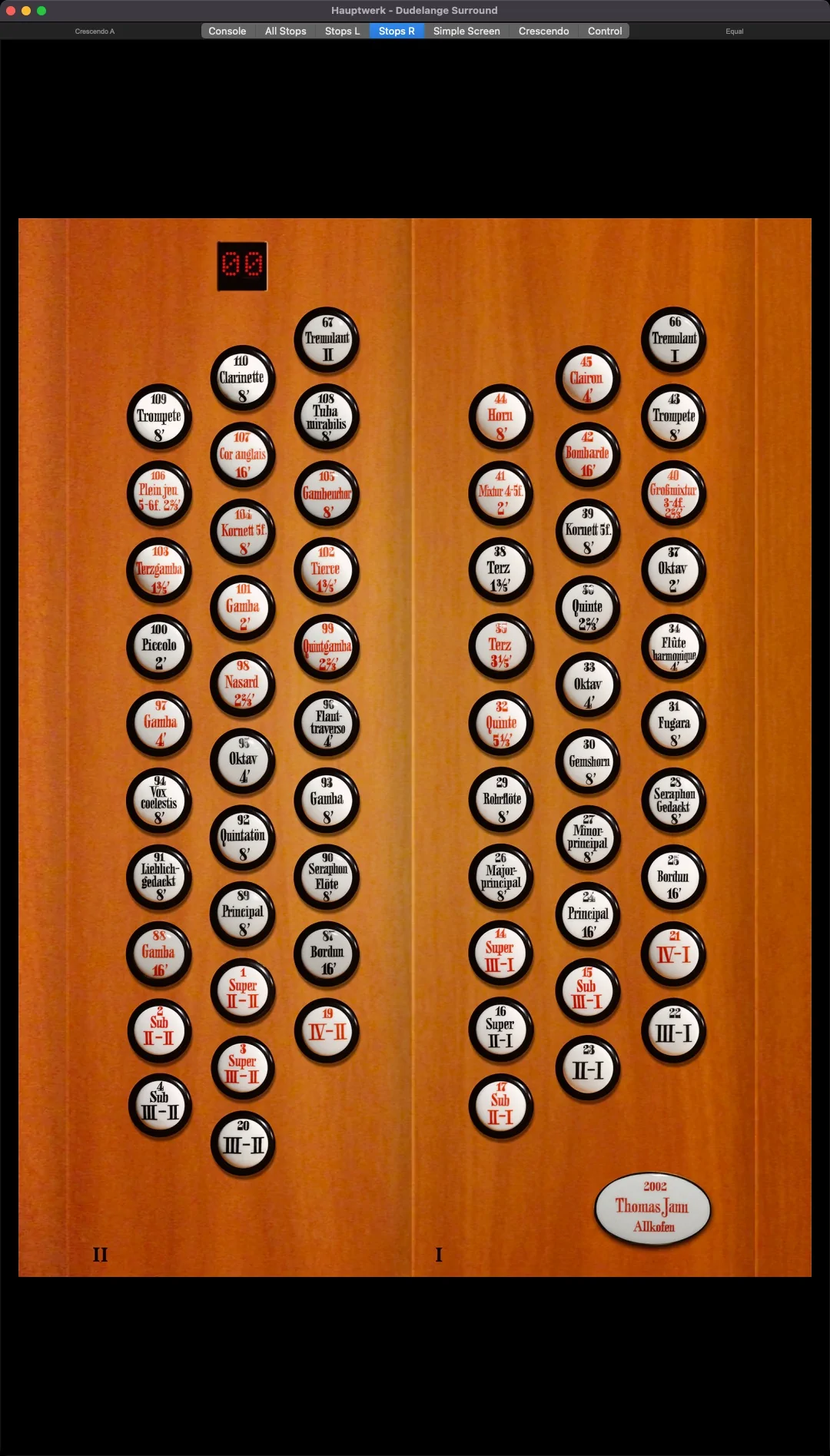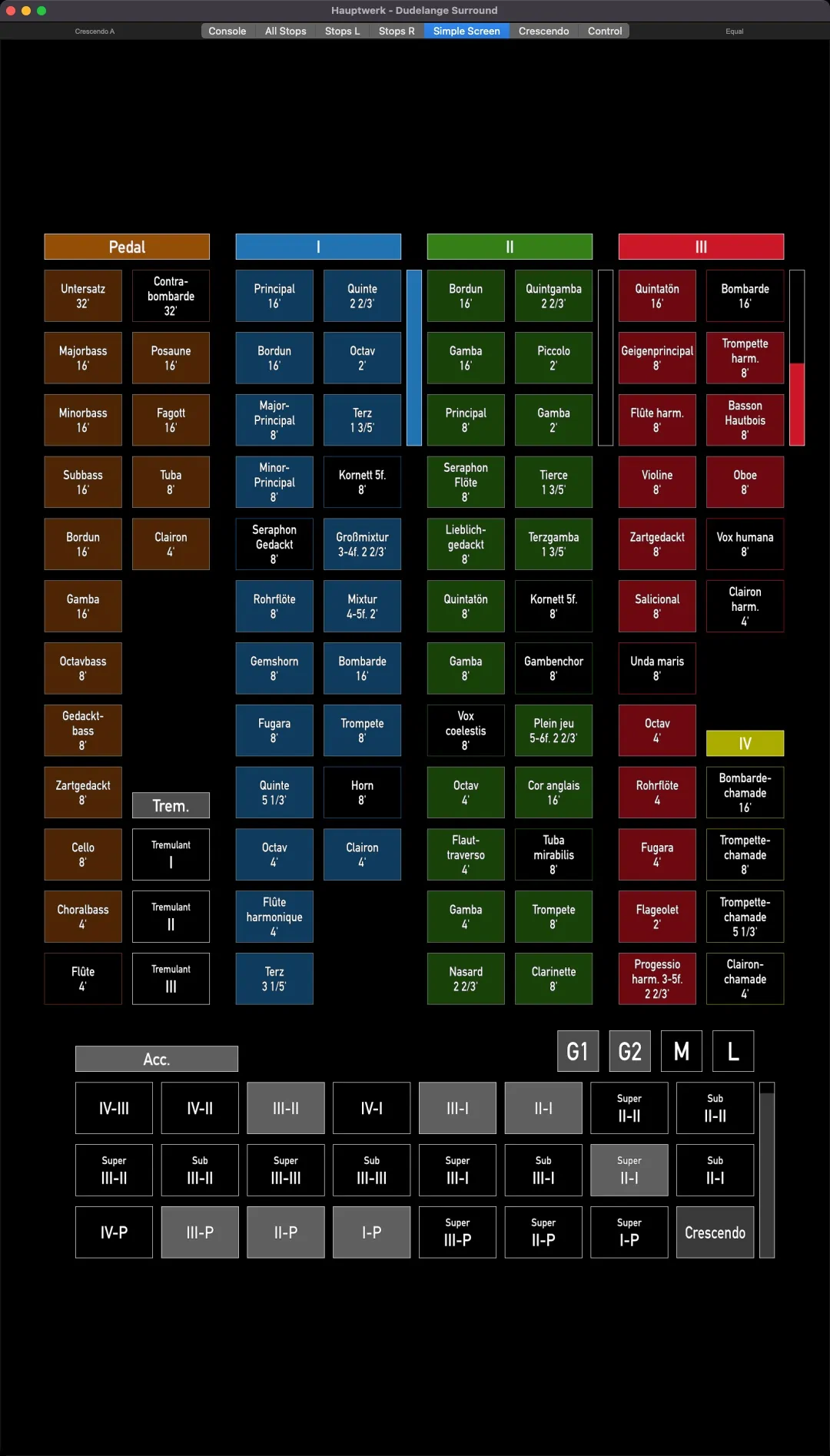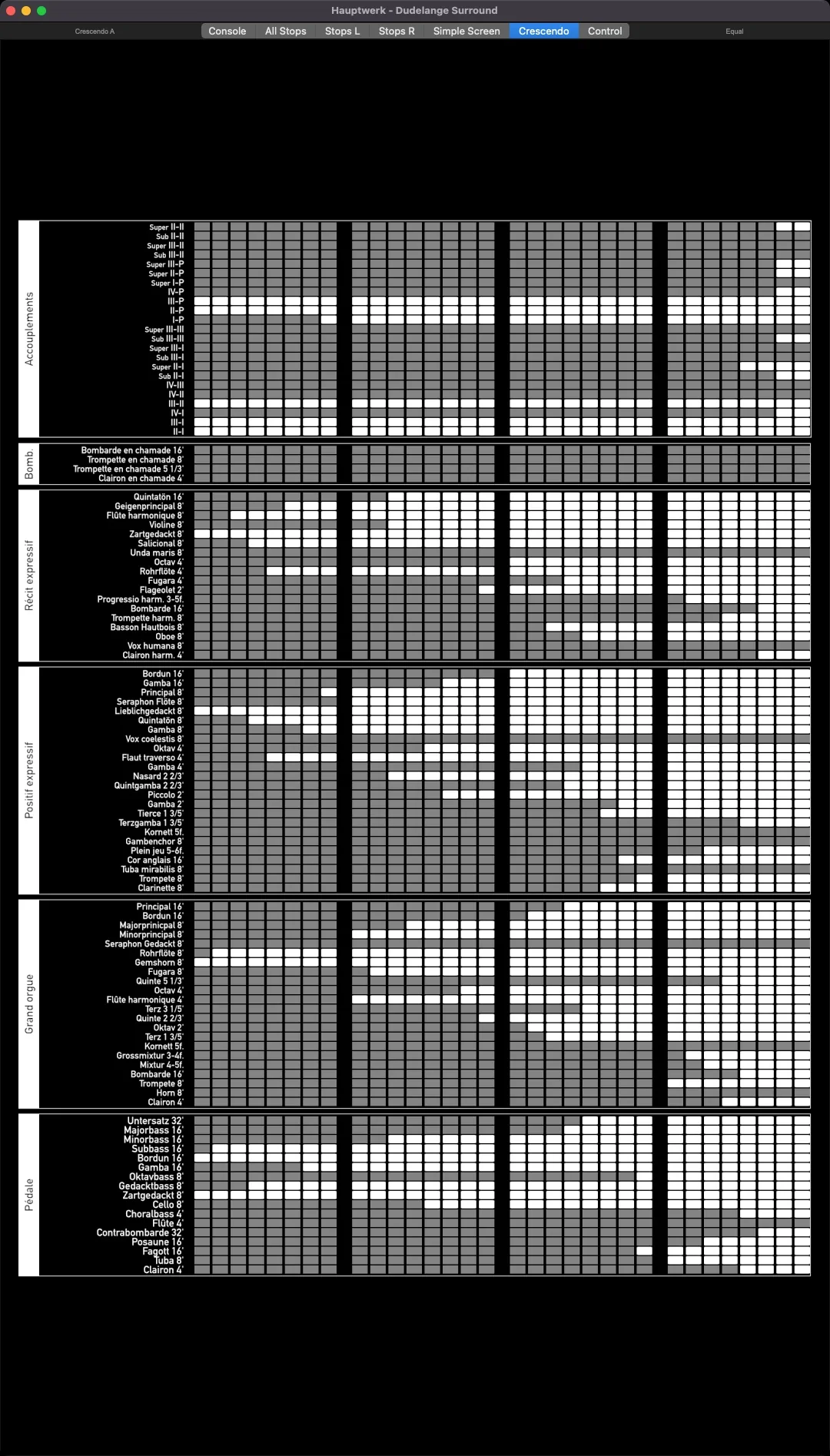This sample set is produced by VOXUS Virtual Organs.
The price for the 4-channel surround set is 624.00 EUR (742.56 EUR incl. German VAT).
For customers outside the European Union the VAT will be deducted.
Note: Dudelange Surround is compatible with Hauptwerk™ version VII or later.
It is not supported on versions V or VI.
About the Organ
The organ of St. Martin’s Church in Dudelange was crafted in 1912 by Georg and Eduard Stahlhuth, brothers from Burtscheid near Aachen. Throughout their lives, the Stahlhuths were close friends with the renowned organ builder Joseph Merklin, under whom they learned the art of organ building. Their expertise, coupled with the commissions they received in England and Ireland, made them one of the few organ builders who successfully blended French and English sound elements into the German-Romantic organ, aligning with Albert Schweitzer’s “European organ building ideas” that served as the foundation for the specifications of the 1912 organ.
The three-manual instrument built in 1912 featured 45 stops (and 3 transmissions under expression in the pedal) on cone valve chests with a pneumatic tracker and stop action. It was powered by three English water motors.
Further borrowing from English sound aesthetics, the Positiv division featured a high-pressure Tuba mirabilis 8′, playing at 300 mm of wind pressure. In addition to the characteristic overblowing stops of Stahlhuth, the organ incorporated French features such as reeds of French-style construction (with tin-plated shallots) and three stops supplied by the Paris organ pipe manufacturer Veuve Jules Sézerie: Vox humana 8′, Tuba 8′, and Posaune 16′ «octave grave de bombarde 16′, grosse taille».
However, its fundamental character was German-Romantic, with numerous 8′ stops, different manuals based on various scales (wide, normal, narrow), and dynamic gradations (forte, mezzoforte, piano). Besides the high-pressure Tuba mirabilis, the organ had two additional so-called „Starkton-Register“: Seraphon Gedackt 8′ and Seraphon Flöte 8′, each with two labia. These three exceptionally loud stops, along with numerous fundamental voices and two swell divisions with their sub-octave and super-octave couplings, provided the organ with an exceptionally wide dynamic range.
In 1962, due to its stylistic quirks, this organ underwent significant changes in its technical and tonal structure to align with the neo-baroque sound aesthetics of the era. These changes included reducing wind pressure, replacing the pneumatic action with electric action, removing the original console, altering the pipework, transferring entire stops to other windchests, incorporating high-pitched mixtures and alterations, adding a fourth manual designed in the neo-baroque style, and finally eliminating distinctive Stahlhuth stops.
After the organ had become barely playable in the middle of the 90s, years of meticulous studies finally allowed the long-awaited renovation to commence. Led by the renowned organ builder Thomas Jann, Allkoven, Germany, the renovation took place from 2001 to 2002. During this transformative period, a range of significant improvements were completed, transforming the organ into a magnificent instrument once again.
- Restoration and reconstruction of the Stahlhuth pipes and windchests from 1912
- Renewal of the swell boxes and the wind supply system
- Removal of the stops added in 1962
- Addition of a Bombarde division instead of the neobaroque Positiv
- Harmonious extension of the organ up to 78 speaking stops with both German romantic and French symphonic tone colors, notably by :
- Further development of the string chorus (full-fledged chorus from 16’ through Terzgamba 1 3/5’)
- Numerous orchestral solo stops, constructed and voiced in both German and French style
- Extension and differentiation of the numerous reed chorus (23 stops in all) of both German romantic and French symphonic style on all manuals
- A strong fundamental tone based on 32’ (Untersatz 32’ from CC, full-length Contrabombarde 32’)
- Octave mutations 5 1/3’ and 3 1/5’ and low-pitched, partly progressive mixtures
- Revoicing of the whole organ was carried without compromise according to romantic voicing techniques
- Installation of a new four-manual console with electronic combination action, MIDI-interface, and replay system
Since 2002, the organ’s most notable feature has been its authentic performance of German, French, and English romantic-symphonic repertoire.
Stop List
I. Hauptwerk
Prinzipal 16′ *
Bordun 16′ *
Majorprinzipal 8′ *
Minorprinzipal 8′ *
Seraphon Gedackt 8′ *
Rohrflöte 8′ *
Gemshorn 8′ *
Fugara 8′ *
Quinte 5 1/3′
Octav 4′ *
Flûte harmonique 4′ *
Terz 3 1/5′
Quinte 2 2/3′ *
Octav 2′ *
Terz 1 3/5′ *
Großmixtur 3-4 fach 2 2/3′
Mixtur 4-5 fach 2′
Bombarde 16′
Trompete 8′ *
Horn 8′
Clairon 4
Tremulant
II. Positiv
Bordun 16′ *
Gamba (Ext. Gamba 8′) 16′
Prinzipal 8′ *
Seraphon Flöte 8′ *
Lieblichgedackt
(Ext. Bordun 16′) 8′ *
Quintatön 8′ *
Gamba 8′ *
Vox coelestis 8′ *
Octav 4′ *
Flute traverso 4′ *
Gamba (Ext. Gamba 8′) 4′
Nasard 2 2/3′
Quintgamba 2 2/3′
Piccolo 2′ *
Gamba (Ext. Gamba 8′) 2′
Tierce 1 3/5′
Terzgamba 1 3/5′
Plein-jeu 5-6 fach 2 2/3′
Cor anglais 16′
Tuba mirabilis (300 mm) 8′ *
Trompete 8′ *
Clarinette 8′ *
Tremulant
III. Schwellwerk
Quintatön 16′
Geigenprinzipal 8′ *
Violine 8′ *
Flûte harmonique 8′ *
Zartgedackt 8′ *
Salicional 8′ *
Unda maris 8′ *
Octav 4′
Rohrflöte 4′ *
Fugara 4′ *
Flageolet 2′ *
Progr. harm. 3-5fach 2 2/3′
Bombarde 16′
Trompette harmonique 8′
Basson Hautbois 8′
Oboe 8′ *
Vox humana 8′ *
Clairon harmonique 4′
Tremulant
III. Bombardwerk
Bombarde en chamade 16′
Trompette en chamade 8′
Trompette en chamade 5 1/3′
Clairon en chamade 4′
P. Pedal
Untersatz 32′ *
Majorbass 16′ *
Minorbass 16′ *
(Tr. Princ. 16′ I)
Subbass 16′ *
Bordun 16′ *
(Tr. Bordun 16′ II) 16′
Gamba 16′
(Tr. Gamba 16′ II)
Oktavbass 8′ *
Gedacktbass 8′
Zartgedackt 8′ *
(Tr. Lieblichgedackt 8′ II) 8′
Cello 8′ *
Flûte 4′
Choralbass 4′
(Ext. Oktavbass)
Contrabombarde 32′
(Ext. Posaune 16′)
Posaune 16′ *
Fagott 16′
Tuba 8′ *
Clairon 4′
Compass
Manual compass: C – c⁴
Pedal compass: C – g¹
* = restored or reconstructed stops from 1912
Couplers
P/I; I/P; II/P; III/P; IV/P; Super I/P; Super II/P; Super III/P;
II/I; III/I; IV/I; Sub II/I; Super II/I; Sub III/I; Super III/I; III/II; IV/II; Sub III/II; Super III/II; Sub II/II; Super III/III; IV/III
Sample Set
-
Two stereo channels of chromatically sampled stops.
-
Beautiful console screen.
-
Single and dual photorealistic jambs for both landscape and portrait orientations.
-
Simple screen for both landscape and portrait orientations, optimized for touchscreens.
-
Modeled tremulants for Hauptwerk, Positiv and Schwellwerk.
-
Recorded tremulants for three reed stops.
-
Enclosures for two divisions.
-
A user-programmable crescendo, eliminating the need for the Hauptwerk internal crescendo.
-
Tonal mute piston to alter the brightness of the Chamade stops.
-
Switch to limit the maximum volume of the Schwellwerk from 32 to 25.
-
Acoustic control slider to enable smooth transitions between the two perspectives.
RAM Requirements
2-channel, 24-bit lossless compression: 30.0 GB
2-channel, 20-bit lossless compression: 28.0 GB
2-channel, 16-bit lossless compression: 15.5 GB
Audio Samples
Nathan Laube
Gioachino Rossini: Ouvertüre aus Wilhelm Tell (trans.: N.J. Laube)
Jan Hage
Maurice Duruflé: Suite pour Orgue Op. 5: Prélude
Richard McVeigh
Max Reger: Introduction & Passacaglia D minor
